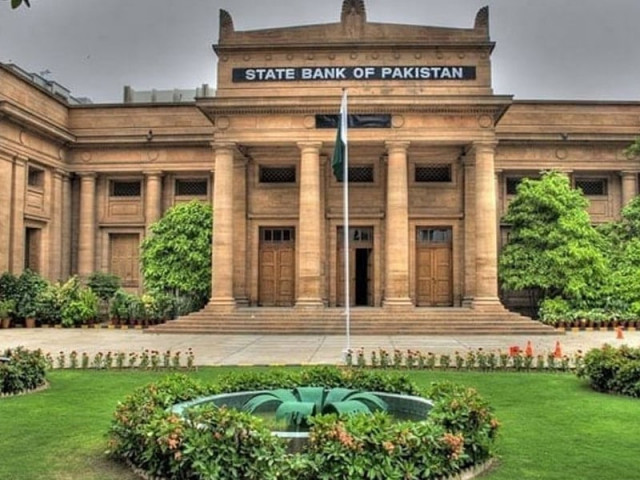SBP slashes policy rate amid falling inflation
MPC announces 200 points reduction to 13% Headline inflation comes down to 4.9% Central bank projects improved g

The State Bank of Pakistan (SBP) maintained on Monday its strategy of a gradual interest rate cut, slashing the policy rate by 200 basis points to 13% on the back of a decline in headline inflation, which plummeted to 4.9% in November, as well as improved growth prospects in the economy.
The rate cut, announced by the Monetary Policy Committee (MPC), effective December 17, 2024, is the fifth consecutive rate cut in the ongoing monetary easing cycle. The latest cut brings the total reduction during the current year to a historic 900bps.
The decision is driven by a fall in headline inflation, which dropped to 4.9% year-on-year in November, as well as improved growth prospects in the economy. However, core inflation remained persistent, and the SBP had emphasised that further policy actions would depend on evolving economic data.
"The Monetary Policy Committee (MPC) decided to cut the policy rate by 200 bps to 13 percent, effective from December 17, 2024," said the MPC said in a statement. It added that the headline inflation fell in line with the MPC's expectations.
Analysts said the deceleration was mainly driven by the continued decline in food inflation as well as the phasing out of the impact of the gas tariffs hike in November. "[It's] an unprecedented monetary easing in CY24, with a cumulative 900bps rate cut over the year," Tahir Abbas, the Director Equities, AHL said.
However, the MPC noted that the core inflation – at 9.7 – was proving to be sticky, whereas inflation expectations of consumers and businesses remained volatile. It was projected to average around 8-9% in the coming months and likely to slow the pace of further policy rate cuts.
SBP Governor Jameel Ahmed said that there was no specific real interest rate target. Regarding the outlook on the rates, he emphasised that the policy stance would remain to be data-driven, with decisions based on prevailing economic conditions and key indicators.
To this effect, the MPC reiterated its previous assessment that inflation might remain volatile in the near term before stabilising in the target range. "At the same time, the growth prospects have somewhat improved, as reflected by the recent uptick in high-frequency indicators of economic activity."
Overall, the statement stated, the MPC assessed that its approach of measured policy rate cuts was keeping inflationary and external account pressures in check, while supporting economic growth on a sustainable basis.
The MPC noted key developments since its last meeting that might have implications for the macroeconomic outlook: First, the current account remained in surplus for the third consecutive month in October 2024, helping the SBP increase foreign exchange reserves to around $12 billion;
Second, global commodity prices remained generally favourable, with positive spill-overs on domestic inflation and the import bill; third, credit to the private sector recorded a noticeable increase, broadly reflecting the impact of ease in financial conditions and banks' efforts to meet the advances-to-deposit ratio (ADR) thresholds; and lastly, the shortfall in tax revenues from the target has widened.
Based on these developments, the MPC assessed that the impact of the cumulative reduction in the policy rate from June 2024 was beginning to unfold and would continue to materialise over the next few quarters.
In this context and taking into account the latest decision, the MPC noted that the real policy rate remained appropriately positive to stabilise inflation within the target range of 5-7%. The SBP said the incoming data suggests improved economic growth prospects.
"In agriculture, risks to crop outlooks have reduced, with better-than-expected cotton arrivals and positive wheat sowing indicators. Industrial activity is also gaining momentum, with strong growth in key manufacturing sectors like textiles, food, and automobiles," it said.
"High-frequency indicators such as sales of cement, auto, and POL products indicate continued industrial growth. This, along with easing inflation and improving business confidence, is expected to support the services sector and drive GDP growth in FY25 within the upper half of the 2.5-3.5% range," it added.
External sector
The current account posted a surplus of $0.2 billion during July-October period of the current financial year, 2024-25, driven by strong workers' remittances and export growth, particularly in HVA textiles, rice, and POL.
Favourable global commodity prices helped limit import costs despite higher import volumes. The surplus, along with improved foreign investment, supported the SBP's foreign exchange reserves, despite weak official inflows.
"Going forward, continued growth in remittances and exports, along with favourable commodity prices, is expected to keep the current account deficit within the 01% of GDP range in FY25, allowing SBP's FX reserves to exceed $13 billion by June 2025," the statement said.
Fiscal sector
Revised fiscal data for the first quarter July-Sept, 2024 – showed improvements in both overall and primary balances. The Federal Board of Revenue (FBR) revenues grew by 23% year-on-year in July-November period, though still below the required growth to meet the annual tax target.
Lower domestic debt yields would result in significant savings on interest payments, helping contain the fiscal deficit. However, achieving the targeted primary surplus would be challenging and require additional efforts and measures to meet the revenue target, the statement said. "This underscores the need for fiscal reforms to broaden the tax base for fiscal consolidation."
Secondary market yields for 3-month and 12-month Pakistan Treasury Bills (PKRV) had already decreased to approximately 11.9% and 12.1%, respectively, last week, indicating that the market had anticipated this rate cut, said JS Global analyst Waqas Ghani Kukaswadia.
Money and Credit
Broad money (M2) growth slowed to 13.9% year-on-year by end-November, down from 15.2% at the last MPC meeting. This slowdown was mainly because of reduced government borrowing, while the contribution of NFA in M2 growth increased.
Banks' lending to the private sector and non-bank financial institutions grew as financial conditions eased and banks aimed to meet minimum ADR thresholds by December 2024. Credit to private businesses rose significantly, with consumer financing also increased in October 2024. On the liability side, deposits continued to drive M2 growth, though the currency-to-deposit ratio rose slightly.



















COMMENTS
Comments are moderated and generally will be posted if they are on-topic and not abusive.
For more information, please see our Comments FAQ